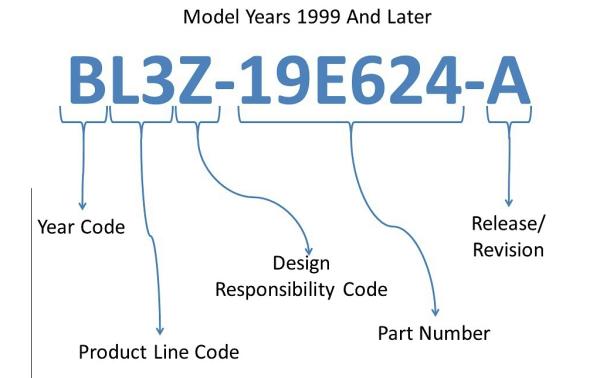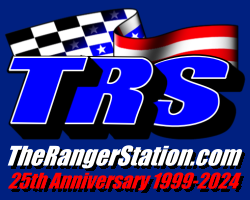
Ford part numbers are divided into two main categories Engineering and Service.
The engineers will design a part and assign it an Engineering part number, which is an alphanumeric reference code. When the part is redesigned the change needs to be noted so the Engineering part number is changed. When the part is released for Service it is assigned a Service part number. This allows Ford Parts and Service to track changes affecting interchangeability by modifying the Ford Service part number. The Service part number will not change with the Engineering part number unless the change affects interchangeability.
Due to this the part numbers on the part are generally Engineering numbers and the Service part number will be on the box. There are some exceptions, such as a whole grouping of parts or a kit. Engineering and Service numbers decode the same way.
The difference is the 4th character of the prefix. Part numbers consist of a;
-
Prefix
-
Basic part number
-
suffix
Example:
An example would be F17A-6002-HB
F17A (prefix), 3002 (basic part number), -HB (suffix).
First Character:
The 1st character of the prefix indicates the decade of design;
-
A = 1940’s
-
B = 1950’s
-
C = 1960’s
-
D = 1970’s
-
E = 1980’s
-
F = 1990’s
-
G = 2000’s
Second Character:
The 2nd Character of the indicates the year within the decade. F1 would represent 1991.
Third Character:
The 3rd character of the prefix indicates the Product Line (See chart below) the part was originally designed for, with few exceptions. Note that “outside sales (code F), “Motorcraft Brand” (code P), or imported parts from Ford of Europe (code R) are identified with their product line code in the third position. In this example, the 7 = Ranger.
Fourth Character:
The 4th character indicates the Part Source (See Source Code chart below), whether it is product engineering office or service part. In this example A= Light Truck Engineering.
The part number F17A-6002-HB would equate to;
F1 = 1991
7 = Ranger
A = Light Truck Engineering
The next group of numbers describe the part.
Suffix designations generally begin with “A” and increment through the alphabet as design changes are made that affect interchangeability. If the suffix on the part I was looking to replace (my existing part) was an “A” I could use parts with a “B” suffix. If the part I was looking to replace (my existing part) had a “B” suffix, a part with the “A” suffix would probably have a compatibility issue. Parts that have later suffix codes are the ones to get.
| Third Character | Product Line
Use the third character of the part number with this chart. |
| A | Ford, 1958-later |
| B | Bronco, 1970-73; Maverick 1975-77; Fairmont 1978-83 |
| C | Remanufactured parts 1966-75 |
| D | Falcon 1960-69; Maverick 1970-74; Granada 1975-82; LTD 1983-later |
| E | Truck (cab over engine) 1970-73; Pinto1976-80; Escort 1981-later |
| F | Outside sales1962-later |
| G | Comet 1961-67; Montego1968-76; EXP 1982-later |
| H | Heavy truck 1966-82; Medium and heavy truck 1983-later |
| I | Not Used |
| J | Industrial Engines |
| K | Edsel 1958-60; Cab trucks 1970-73; Comet 1975-77; Zephyr 1978-83; Marquis 1983-later |
| L | Lincoln 1958-60; Mark 1961-later |
| M | Mercury 1958-later |
| N | Tractor 1958-later |
| O | Fairlane 1962-68; Torino 1969-76; LTD II 1977-79; LN7 1982-83 |
| P | Motorcraft (or Autolite) 1962-later |
| Q | Not Used |
| R | Rotunda Brand1962-69; vehicles imported from Ford of Europe1970-later |
| S | Thunderbird 1958-later |
| T | All truck 1958-65; light and medium truck including Bronco 1974-82; light truck and Bronco I 1983-later |
| U | Econoline 1961-later |
| V | Lincoln Continental 1961-81; |
| W | Cougar 1966-72; Bobcat 1975-80; Lynx 1981-later |
| X | Trucks (short highway) 1970-73 |
| Y | Meteor (Canadian) 1962-73; Bobcat 1975-80; Lynx 1981-later |
| Z | Mustang 1964-73; Mustang II 1974-78; Mustang 1979-later |
| 1 | Not Used |
| 2 | Pinto 1971-75 |
| 3 | Tempo 1984-later |
| 4 | Comet 1971-74; Monarch 1975-80; Cougar 1981-82; Marquis 1983-later |
| 5 | Recreational vehicles 1974-75; Continental 1982-later |
| 6 | Pantera 1971-75; Ranger and Bronco II 1983-later |
| 7 | Courier truck 1971-75; Ranger and Bronco II 1983-later |
| 8 | Capri (US designed parts) 1972-75 |
| 9 | Turbine engine parts 1970-75 |
| Fourth Character | Source Codes
Use the fourth character of the part number with this chart. |
| A | Light truck Engineering |
| B | Body and electrical product Engineering |
| C | Chassis Engineering ; Powertrain and Chassis product Engineering |
| D | Overseas product Engineering |
| E | Engine Engineering; Powertrain and Chassis product Engineering |
| F | Electrical and Electronics Division; Product Engineering office |
| G | Not Used |
| H | Climate Control Division; Product Engineering office |
| I | Not Used |
| J | Ford Parts and Service Division; Parts and Service Engineering office |
| K | Not Used |
| L | Ford Parts and Service Division; Industrial Engine Operations |
| M | Performance Operations; SVO Service Parts |
| N | Ford Tractor Operations; Product Engineering Office; Diversified Products Operations |
| O | Not Used |
| P | Transmission and Axle Engineering; Powertrain and Chassis Product Engineering (Automatic Transmissions) |
| Q | Not Used |
| R | Transmission and Axle Engineering; Powertrain and Chassis Product Engineering (Manual Transmissions) |
| S | Light and Heavy Truck Engineering; Truck Special Ordering Department |
| T | Heavy Truck Engineering |
| U | Special Vehicles Operations |
| V | Vehicle Special Ordering and Engineering Section |
| W | Transmission and Axle Engineering; Powertrain and Chassis Product Engineering (axle) |
| X | Emissions, Economy and Special Vehicle Engineering |
| Y | Ford Parts and Service Division; Parts Engineering Office (Lincoln Mercury Division Service Parts) |
| Z | Ford Parts and Service Division; Parts Engineering Office (Ford Division Service Parts) |
Decoding Dates
Date codes are sometimes included on parts. The 1st digit is the last number of the year. To determine the decade, refer to the part number’s prefix. The 2nd digit is the month. Note that the character “I” is not used. The months are;
- A = January
- B = February
- C = March
- D = April
- E = May
- F = June
- G = July
- H = August
- J = September
- K = October
- L = November
- M = December
The 3rd digit is the day of the month.
